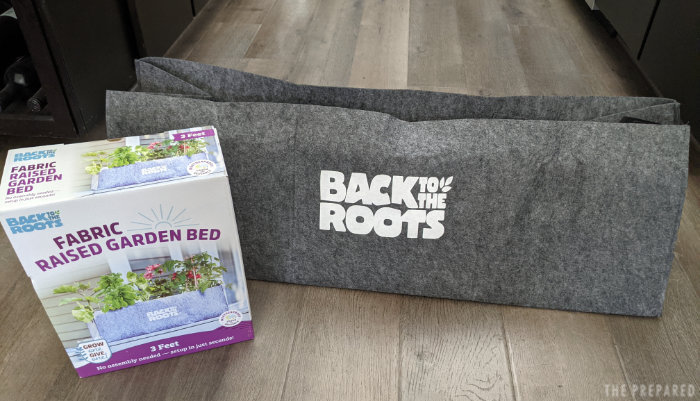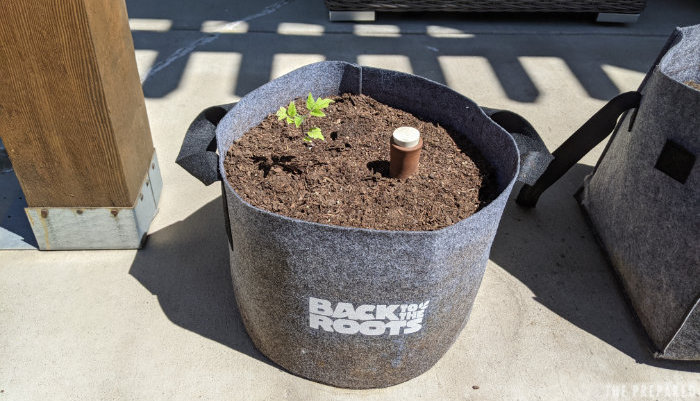Review: Back to the Roots fabric raised garden bed, self-watering Olla system, and organic seeds
Punchline: Great as a gift or hobby, but not ideal for prepping. This past summer, I was feeling a bit envious after reading all the incredible posts from Josh, Redneck, and the rest of the community. I wanted to start growing something in my backyard. Unfortunately, I can't plant directly in the soil due to some conditions, so I figured a raised bed was my best bet. However, I was too busy to build my own or even thoroughly research existing options. That's when I discovered Back to the Roots, and I decided to give it a shot. Back to the Roots is a small American company that offers organic seeds, organic potting mix, and growing kits, including mushroom kits, hydroponics/aquaponics systems, and fabric raised beds. Their mission is to reconnect families and future generations with the source of their food—no green thumb or backyard required—and they’re B Corp certified. I purchased: Fabric raised beds are designed to be breathable, encouraging strong root development. They're easy to set up since there's no assembly required, and the material is lightweight. Both the bed I bought and the self-watering pot can fit in a small space. The fabric bed and the self-watering pot are made of thick felt, with stitched-in handles. The 3 cubic feet garden bed has two internal dividers, making it easy to grow different types of plants or implement a square-foot garden. The fabric feels durable and sturdy. Setting it up was a breeze. All I had to do was unfold the fabric and fill it with soil. The hardest part was carrying the soil to the bed. The self-watering pot has a 5-gallon capacity and includes a small terracotta Olla that holds about 20 ounces (around 2.5 cups) of water. The stopper is made of rubber. An Olla is an unglazed pot buried near the plant you want to grow, filled with water for sub-surface irrigation. It's an ancient technique used for thousands of years in dry regions. The Organic Beginner’s Garden seed pack included cilantro, basil, onion, cherry tomatoes, spinach, arugula, lettuce, carrots, beans, and radishes. I germinated a few cherry tomatoes indoors first, then planted the healthiest-looking ones in the 5-gallon fabric pot with the Olla. I planted radishes directly in the soil in the rectangular bed. The tomato plant did well: it eventually needed regular feeding, but I understand that's typical for tomatoes, so I incorporated it into my watering routine. I realized that one tomato plant wasn’t enough to provide enough produce for two people (not enough mature tomatoes to even make a decent salad). We ended up snacking on them as soon as they ripened. I had high hopes for the Olla, but I’m not sure I truly benefited from it. I expected it to keep the soil moist for several days, but I ended up refilling it almost daily, and the soil still wouldn’t stay consistently moist. Without testing the same tomatoes in a similar setup but without an Olla, it’s hard to make an accurate assessment, but I suspect several factors influenced the outcome: extreme temperatures (consistently in the high 90s to 100s), a relatively small amount of soil to retain moisture (5 gallons versus a larger bed, or even the infinite soil available if planted directly in the ground), and the fact that the bed was made of fabric. Additionally, the Olla may have been too small for this setup (high heat + small fabric bed). The beds were also on top of a concrete patio, which likely increased the temperature around them. I also noticed that the more I watered the beds, the more the soil collapsed the sides of the rectangular bed, causing the soil level to drop and creating more shade within the bed. At one point, I didn’t want to add more soil because I had radishes growing inside, but this caused some of the radishes (the ones planted near the sides) to chase the sunlight, resulting in long stems with leaves instead of proper bulbs. One of the handles also broke when I tried to move the bed while it was already full. It wasn’t a huge issue since it was my mistake to attempt moving it once filled, but it was still disappointing. I also didn’t like seeing the logo prominently displayed, so I turned it away from our sitting area. While the logo makes sense in the context of their Grow One, Give One campaign (for every picture of a Back to the Roots garden shared on social media, they donate an organic grow kit and STEM curriculum to an elementary school classroom of your choice), I dislike when companies make their logos overly prominent. The gray fabric showed water and soil stains the more I watered them. This was purely aesthetic and didn’t affect functionality, but it was unexpected and took some getting used to. In summary, I’m glad I tested the fabric raised beds and the Olla. I’m planning to use them again next year and try planting some of the other vegetables from the seed pack (it’ll be interesting to see if they still germinate). I don’t think so. If I wanted to grow enough produce for two people, I wouldn’t rely on them. I’d need more or bigger beds, and there are cheaper options available (though I wonder how the different types of fabric compare to each other). I also keep thinking that fabric beds might not be the best choice for my climate, and if I ever decide to garden on a larger scale, I’d probably opt for more traditional raised beds. As for the seeds, I don’t have any reason to believe they aren’t comparable to any other organic seeds out there, but they seem pricier ($2.99 for a pack of Back to the Roots Roma tomatoes vs $2.49 for Burpee Roma tomatoes found at Home Depot—could probably get a better deal at a local nursery). Terracotta Ollas are expensive individually, but there are plenty of DIY instructions available, which could be more cost-effective. I think every gardening kit offered by Back to the Roots would make great gifts for kids or adults in urban environments, or for those (like me) who want to try growing something but lack the time to plan a proper garden. Even though some of their products are more expensive than shopping around elsewhere, they frequently run promotions, making the prices more reasonable. For instance, right now they offer a Hydroponic/Aquaponic kit for $100 with 25% off site-wide, while a similar aquaponic kit on Amazon is nearly $150. What I appreciated about them is their effort to make gardening accessible, from offering money-back guarantees to providing growing support and free downloadable STEM curricula for kids. Bonus: Check out the excellent and relevant forum post by Ubique about drought and how to prepare for food production. Outdoor bench refers to the seating facilities used in outdoor places, often commonly found in parks, squares, leisure areas, scenic spots and other outdoor environments. The classification of outdoor benches can be introduced according to many aspects such as material, shape and function. Beach Bench,Deck Chair,Deck Bench,Waterproof Bench Foshan Shengshi Zhihui Technology Co., Ltd. , https://www.officer-furniture.com
But are they suitable for prepping?
Who are these for?
First, classification by material
1. Wooden bench: Wooden bench is one of the most common outdoor benches, usually made of natural wood, with natural and environmentally friendly characteristics. Wooden benches are usually made of solid wood or artificial wood, and the surface is treated with waterproof and anti-corrosion, which can adapt to various climatic conditions in the outdoor environment.
2. Metal bench: Metal bench is made of metal materials, such as cast iron, steel, etc. The metal bench is durable, corrosion resistant, easy to clean and is suitable for all kinds of outdoor environments.
3. Stone bench: Stone bench is made of marble, granite and other stone, which has the characteristics of good texture and beautiful appearance. Stone benches are generally suitable for high-end places such as garden scenic spots and can be integrated with the surrounding environment.
5. Combined material bench: Combined material bench refers to the bench made of different materials, such as the combination of wood and metal, stone and plastic combination. Combined material bench can usually combine the advantages of different materials, more in line with the needs of different outdoor environments.
2. Classification by shape
1. Linear bench: Linear bench is the most common shape of bench, generally composed of a row of seats, forming a straight line arrangement. The linear bench is suitable for outdoor places with large pedestrian flow and can provide more seats.
2. Arc bench: Arc bench is an arc bench composed of multiple seats, usually used in a ring seat area or landscape area. The curved bench can not only provide comfortable seating, but also increase the aesthetics of the place.
3. Wavy bench: The wavy bench is a bench composed of multiple seats in the shape of undulating waves, giving people a sense of movement and flow. The wavy bench is suitable for parks, squares and other places that need to increase vitality and fun.
4. Round bench: A round bench is a round bench composed of a number of seats, which is usually used in outdoor recreation areas and can provide a place for groups to gather.
3. Classification by function
1. Leisure bench: Leisure bench is a common form of outdoor bench, it can provide comfortable seats, so that people can relax in the outdoor environment.
2. Viewing bench: Viewing bench is usually set in a scenic outdoor environment, providing comfortable seats for people to enjoy the scenery.
3. Sitting bench: Sitting bench is usually set in parks, squares and other places with large traffic, to provide people with a short rest and relaxation.
4. Cool pavilion bench: Pavilion bench refers to a form of combination of bench and pavilion, which can provide sunshade, rain prevention and other functions, suitable for outdoor leisure areas.
In short, the classification of outdoor benches can be divided from many aspects such as material, shape and function. Different outdoor environments and needs need to choose a suitable bench type to provide comfortable and beautiful seating facilities



